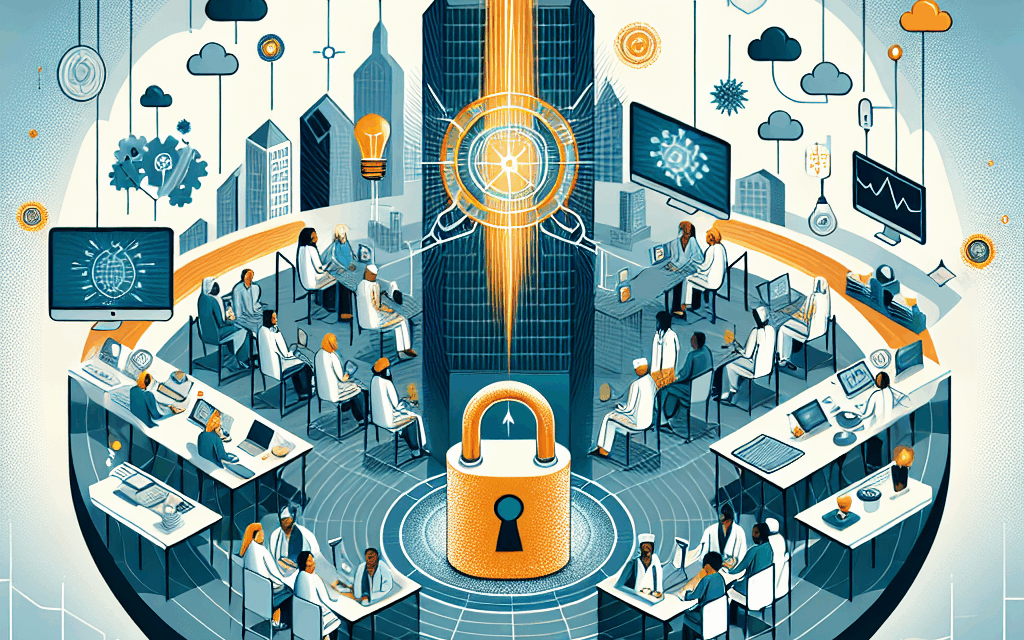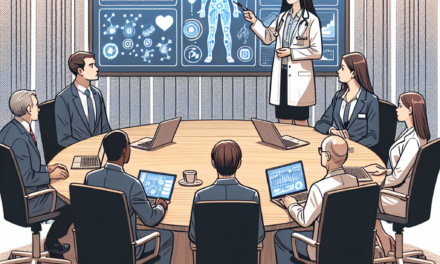Unlocking Healthcare’s Potential: The Crucial Role of Remote Teams in Building Resilience
The healthcare industry is undergoing a transformative shift, driven by technological advancements and the pressing need for resilience in the face of global challenges. Remote teams have emerged as a pivotal component in this evolution, enabling healthcare organizations to adapt, innovate, and thrive. This article explores the crucial role of remote teams in building resilience within healthcare, examining their impact on patient care, operational efficiency, workforce management, technology integration, and future trends.
The Impact of Remote Teams on Patient Care
Remote teams have revolutionized patient care by enhancing accessibility, improving communication, and personalizing treatment plans. The integration of telehealth services has made it possible for patients to receive care from the comfort of their homes, which is particularly beneficial for those with mobility issues or chronic conditions.
Enhancing Accessibility
One of the most significant advantages of remote teams is their ability to enhance accessibility to healthcare services. Telehealth platforms allow patients to connect with healthcare providers regardless of geographical barriers. This is especially crucial in rural areas where healthcare facilities may be limited.
- Telemedicine Services: Remote teams can provide telemedicine services that allow patients to consult with doctors via video calls, reducing the need for travel and wait times.
- Chronic Disease Management: Patients with chronic diseases can receive regular check-ins and monitoring through remote teams, ensuring they adhere to treatment plans and manage their conditions effectively.
- Emergency Response: In emergencies, remote teams can triage patients and provide immediate guidance, potentially saving lives by directing them to the appropriate care facilities.
Improving Communication
Effective communication is vital in healthcare, and remote teams facilitate better interactions between patients and providers. Through various digital platforms, patients can easily reach out to their healthcare teams, ask questions, and receive timely responses.
- Patient Portals: Many healthcare organizations have implemented patient portals that allow individuals to access their medical records, schedule appointments, and communicate with their healthcare providers.
- Follow-Up Care: Remote teams can ensure that follow-up care is seamless, with automated reminders and check-ins that keep patients engaged in their health journey.
- Multidisciplinary Collaboration: Remote teams enable healthcare professionals from different specialties to collaborate effectively, ensuring comprehensive care for patients with complex needs.
Personalizing Treatment Plans
Remote teams can leverage data analytics and patient feedback to create personalized treatment plans that cater to individual needs. This approach not only improves patient satisfaction but also enhances health outcomes.
- Data-Driven Insights: By analyzing patient data, remote teams can identify trends and tailor treatment plans that address specific health concerns.
- Patient Engagement: Engaging patients in their treatment plans fosters a sense of ownership and accountability, leading to better adherence to prescribed therapies.
- Feedback Loops: Remote teams can establish feedback loops that allow patients to share their experiences, enabling continuous improvement in care delivery.
Operational Efficiency Through Remote Teams
Operational efficiency is critical for healthcare organizations striving to provide high-quality care while managing costs. Remote teams contribute significantly to streamlining operations, reducing overhead, and optimizing resource allocation.
Cost Reduction
One of the most immediate benefits of remote teams is the potential for cost reduction. By minimizing the need for physical office space and associated expenses, healthcare organizations can allocate resources more effectively.
- Reduced Overhead Costs: Remote teams eliminate the need for large office spaces, utilities, and other overhead costs associated with maintaining a physical location.
- Flexible Staffing: Organizations can hire remote workers on a contractual basis, allowing for flexibility in staffing levels based on demand.
- Lower Patient Costs: Patients benefit from reduced costs associated with travel and time off work, making healthcare more affordable and accessible.
Streamlined Processes
Remote teams can implement streamlined processes that enhance operational efficiency. By utilizing technology, healthcare organizations can automate routine tasks and improve workflow.
- Automation of Administrative Tasks: Remote teams can automate scheduling, billing, and patient follow-ups, freeing up healthcare professionals to focus on patient care.
- Centralized Communication: Utilizing centralized communication platforms ensures that all team members are on the same page, reducing the risk of miscommunication and errors.
- Data Management: Remote teams can manage patient data more effectively, ensuring that information is up-to-date and accessible to authorized personnel.
Resource Optimization
Remote teams enable healthcare organizations to optimize their resources by ensuring that the right personnel are available at the right time. This is particularly important in a field where demand can fluctuate significantly.
- Dynamic Staffing Models: Remote teams can implement dynamic staffing models that adjust based on patient volume, ensuring that resources are allocated efficiently.
- Cross-Training Staff: Remote teams can cross-train staff to handle multiple roles, increasing flexibility and responsiveness to changing needs.
- Utilization of Technology: Leveraging technology allows remote teams to monitor resource usage in real-time, enabling proactive adjustments to staffing and equipment allocation.
Workforce Management in a Remote Environment
Managing a remote workforce presents unique challenges and opportunities for healthcare organizations. Effective workforce management is essential for maintaining productivity, engagement, and job satisfaction among remote team members.
Recruitment and Onboarding
Recruiting and onboarding remote team members requires a strategic approach to ensure that candidates possess the necessary skills and fit the organizational culture.
- Targeted Recruitment Strategies: Organizations can utilize online platforms and social media to reach a broader pool of candidates, focusing on those with experience in remote work.
- Comprehensive Onboarding Programs: Effective onboarding programs that include virtual training sessions and mentorship can help new hires acclimate to the remote work environment.
- Assessment of Skills: Utilizing assessments during the recruitment process can help identify candidates who possess the skills necessary for remote collaboration and communication.
Employee Engagement and Retention
Maintaining employee engagement and retention in a remote environment is crucial for the success of healthcare organizations. Remote teams can implement various strategies to foster a positive work culture.
- Regular Check-Ins: Frequent one-on-one check-ins between managers and team members can help address concerns and provide support.
- Team Building Activities: Virtual team-building activities can enhance camaraderie and strengthen relationships among remote team members.
- Recognition Programs: Implementing recognition programs that celebrate achievements can boost morale and motivate employees to perform at their best.
Performance Management
Performance management in a remote setting requires clear expectations and metrics to evaluate employee contributions effectively. Remote teams can utilize various tools and techniques to monitor performance.
- Goal Setting: Establishing clear, measurable goals for remote team members ensures that everyone is aligned with organizational objectives.
- Utilization of Performance Metrics: Remote teams can leverage performance metrics and analytics to assess productivity and identify areas for improvement.
- Feedback Mechanisms: Implementing regular feedback mechanisms allows employees to receive constructive criticism and recognition for their efforts.
Technology Integration in Remote Healthcare Teams
The integration of technology is a cornerstone of successful remote healthcare teams. By leveraging innovative tools and platforms, organizations can enhance collaboration, streamline processes, and improve patient outcomes.
Telehealth Platforms
Telehealth platforms have become essential for remote healthcare teams, enabling virtual consultations and remote monitoring of patients. These platforms facilitate real-time communication and data sharing between patients and providers.
- Video Conferencing Tools: Video conferencing tools allow healthcare providers to conduct virtual appointments, ensuring that patients receive timely care without the need for in-person visits.
- Remote Monitoring Devices: Remote monitoring devices enable healthcare teams to track patients’ vital signs and health metrics, allowing for proactive interventions when necessary.
- Integration with EHR Systems: Telehealth platforms that integrate with electronic health record (EHR) systems ensure that patient data is accessible and up-to-date, enhancing care coordination.
Collaboration Tools
Collaboration tools are vital for remote teams to communicate effectively and work together on patient care. These tools facilitate information sharing and project management.
- Project Management Software: Utilizing project management software allows remote teams to track tasks, deadlines, and responsibilities, ensuring that everyone is aligned on objectives.
- Instant Messaging Platforms: Instant messaging platforms enable quick communication among team members, fostering collaboration and reducing response times.
- Document Sharing Solutions: Document sharing solutions allow remote teams to collaborate on patient care plans and share important information securely.
Data Analytics and AI
The use of data analytics and artificial intelligence (AI) is transforming how remote healthcare teams operate. These technologies enable organizations to make data-driven decisions and improve patient outcomes.
- Predictive Analytics: Predictive analytics can help remote teams identify patients at risk of complications, allowing for timely interventions and personalized care.
- AI-Powered Chatbots: AI-powered chatbots can assist with patient inquiries, appointment scheduling, and follow-up care, freeing up healthcare professionals to focus on more complex tasks.
- Data-Driven Decision Making: By analyzing patient data, remote teams can identify trends and make informed decisions that enhance care delivery and operational efficiency.
Future Trends in Remote Healthcare Teams
The future of remote healthcare teams is promising, with several trends poised to shape the landscape of healthcare delivery. As technology continues to evolve, organizations must adapt to stay ahead of the curve.
Increased Adoption of Telehealth
The COVID-19 pandemic accelerated the adoption of telehealth services, and this trend is expected to continue. Remote teams will play a crucial role in expanding telehealth offerings and ensuring that patients have access to quality care.
- Hybrid Care Models: The future will likely see a blend of in-person and virtual care, allowing patients to choose the most convenient option for their needs.
- Insurance Coverage Expansion: As telehealth becomes more mainstream, insurance providers are likely to expand coverage for virtual services, making them more accessible to patients.
- Global Reach: Remote teams will enable healthcare organizations to reach patients in underserved areas, bridging gaps in access to care.
Emphasis on Mental Health Services
The importance of mental health has gained recognition in recent years, and remote teams will play a vital role in providing mental health services. Teletherapy and virtual support groups are becoming increasingly popular.
- Accessible Mental Health Care: Remote teams can offer mental health services that are accessible to individuals who may be hesitant to seek in-person care.
- Integration with Primary Care: Integrating mental health services with primary care can lead to more comprehensive treatment plans for patients.
- Focus on Preventive Care: Remote teams can implement preventive mental health programs that promote well-being and resilience among patients.
Advancements in Wearable Technology
Wearable technology is revolutionizing patient monitoring and health management. Remote teams can leverage these advancements to enhance patient care and engagement.
- Real-Time Health Monitoring: Wearable devices can provide real-time data on patients’ health metrics, allowing remote teams to monitor conditions proactively.
- Personalized Health Insights: Data collected from wearables can be analyzed to provide personalized health insights and recommendations for patients.
- Increased Patient Engagement: Wearable technology encourages patients to take an active role in their health management, fostering a sense of accountability.
Focus on Interdisciplinary Collaboration
The future of healthcare will see an increased emphasis on interdisciplinary collaboration among remote teams. This approach ensures that patients receive comprehensive care from a diverse range of specialists.
- Integrated Care Teams: Remote teams will work together to create integrated care teams that address the multifaceted needs of patients.
- Shared Decision-Making: Collaborative decision-making among healthcare professionals will lead to more effective treatment plans and improved patient outcomes.
- Continuous Learning: Remote teams will engage in continuous learning and knowledge sharing, fostering a culture of innovation and improvement.
Conclusion
The role of remote teams in healthcare is more crucial than ever as the industry navigates the complexities of modern challenges. By enhancing patient care, improving operational efficiency, managing the workforce effectively, integrating technology, and embracing future trends, remote teams are unlocking healthcare’s potential and building resilience. As organizations continue to adapt to the evolving landscape, the insights gained from this exploration will serve as a foundation for creating a more accessible, efficient, and patient-centered healthcare system. The future of healthcare is bright, and remote teams will undoubtedly play a pivotal role in shaping it.





